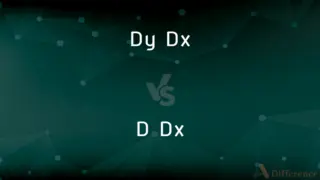Purchase Book vs. Purchase Account — What's the Difference?
By Tayyaba Rehman — Published on December 23, 2023
Purchase Book records detailed credit transactions of goods bought. Purchase Account is a ledger account reflecting total purchases value.

Difference Between Purchase Book and Purchase Account
Table of Contents
ADVERTISEMENT
Key Differences
The Purchase Book is a special subsidiary book wherein all credit transactions related to the purchase of goods are recorded. The Purchase Account, conversely, is a ledger account in which the total value of goods purchased on credit and cash is accumulated.
In businesses, the Purchase Book acts as a chronological record, capturing each credit purchase transaction in detail. On the other hand, the Purchase Account is a summary account, showing the overall balance of all purchases made during a certain period.
Having a Purchase Book is essential as it helps in tracking specific transactions, providing insights on terms, vendors, and specific details of every purchase. Whereas the Purchase Account gives a bird's-eye view, summarizing the total value of all such transactions.
While the Purchase Book is strictly for recording credit transactions of goods, the Purchase Account also includes cash purchases. It's important to note that the Purchase Book, once totaled, is posted to the Purchase Account.
The very nature of these tools is distinct: The Purchase Book is more about detailed documentation, while the Purchase Account emphasizes on accumulation and summary.
ADVERTISEMENT
Comparison Chart
Nature
Subsidiary book
Ledger account
Function
Records details of credit purchases
Reflects total value of all purchases
Transactions Included
Only credit transactions of goods
Both credit and cash purchases of goods
Usage
Track individual transactions
Get an overall balance of purchases
Detail Level
Detailed transactions with specifics
Summarized view of purchases
Compare with Definitions
Purchase Book
Purchase Book is a chronological record of credit purchases.
The Purchase Book showed a recent transaction with their primary vendor.
Purchase Account
Purchase Account provides an overview of total purchasing activity.
A spike in the Purchase Account alerted the manager to increased spending.
Purchase Book
Purchase Book offers detailed insights into each purchase transaction.
The discrepancy was traced back to an entry in the Purchase Book.
Purchase Account
Purchase Account is a summary of all purchase transactions.
The balance in the Purchase Account indicated a higher expenditure this month.
Purchase Book
Purchase Book is a subsidiary book for documenting credit transactions related to goods.
By checking the Purchase Book, they verified the terms of their last order.
Purchase Account
Purchase Account is a tool to get a consolidated view of all purchases.
Reconciliations often involve matching the Purchase Book totals with the Purchase Account.
Purchase Book
Purchase Book captures the specifics of goods bought on credit.
The Purchase Book highlighted frequent purchases from a new vendor.
Purchase Account
Purchase Account captures the net effect of all purchase transactions.
The annual report showed a balanced Purchase Account, indicating stable purchasing activity.
Purchase Book
Purchase Book is an essential tool for tracking vendor interactions and purchase terms.
The audit team spent hours reviewing the Purchase Book for inconsistencies.
Purchase Account
Purchase Account is a ledger that accumulates values of both credit and cash purchases.
The Purchase Account reflected the recent cash discounts availed.
Common Curiosities
What type of transactions go into the Purchase Book?
The Purchase Book records only credit transactions related to goods.
Which provides a more detailed view, the Purchase Book or Purchase Account?
The Purchase Book offers a detailed view, while the Purchase Account is more summarized.
Can cash purchases be found in the Purchase Book?
No, the Purchase Book only records credit purchases of goods.
Are returns reflected in the Purchase Book?
No, returns have separate return books. The Purchase Book only captures purchases.
How does one verify the accuracy of the Purchase Account?
By ensuring the Purchase Book's totals and other entries correctly post to the Purchase Account.
Why is the Purchase Book essential for businesses?
The Purchase Book helps in tracking specific transactions and vendor interactions.
Is the Purchase Account updated frequently?
The Purchase Account is updated based on the totals from the Purchase Book and other related entries.
Can a Purchase Book be maintained digitally?
Yes, many modern accounting software offer digital versions of the Purchase Book.
Does the Purchase Account show individual transaction details?
No, the Purchase Account provides a summarized view of total purchases.
What's the relationship between the Purchase Book and Purchase Account?
Totals from the Purchase Book are posted to the Purchase Account.
Can we determine vendor-specific transactions from the Purchase Account?
No, for vendor-specific details, one would refer to the Purchase Book.
Is the Purchase Account used for reconciliation?
Yes, reconciliations often involve matching the Purchase Book with the Purchase Account.
Do all businesses maintain a Purchase Book?
While advisable, not all businesses might maintain a Purchase Book, especially smaller entities.
How often is the Purchase Book updated?
The Purchase Book is updated as and when credit purchase transactions occur.
Which tool is ideal for tracking purchase trends over time?
The Purchase Account gives an overview, making it suitable for tracking trends.
Share Your Discovery

Previous Comparison
dy dx vs. d dx
Next Comparison
BMI vs. BSAAuthor Spotlight
Written by
Tayyaba RehmanTayyaba Rehman is a distinguished writer, currently serving as a primary contributor to askdifference.com. As a researcher in semantics and etymology, Tayyaba's passion for the complexity of languages and their distinctions has found a perfect home on the platform. Tayyaba delves into the intricacies of language, distinguishing between commonly confused words and phrases, thereby providing clarity for readers worldwide.














































